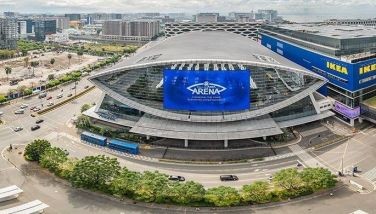Istanbul, once called Constantinople

ISTANBUL — We’re here on an observation tour sponsored by the Turkish Flour, Yeast and Ingredients Promotion Group (TYFI) of historical and cultural sites of the fabled land.
Only twice during our seven-day visit would our group have brief meetings with Turgay Unlu, chairman of the board of TYFI, his comely female legal counsel Ozlem Canbeldek, and young businessman/flour miller Avsin Kasikci in Istanbul. Unlu tells us members of the Philippine Tariff Commission are set to visit Turkey next month to conduct an independent investigation into the allegations of unfair trade and dumping of Turkish flour in the Philippines by the Philippine Association of Flour Millers (PAFMIL) and the US Wheat Association (USWA). He will also be in Manila to attend the WOFEX World Food Expo.
In effect this month is a temporary measure against eight out of 16 Turkish flour importers in the Philippines by the Tariff Commission which acted upon a petition filed by PAFMIL members. The PAFMIL members complain about Turkish flour being priced much lower than their flour, in fact, lower than the flour that’s sold in Turkey’s retail market. They express the possibility of Turkish flour monopolizing the local flour industry.
In our meeting Unlu expresses optimism that the Tariff Commission will remove the temporary safeguard measure. He tells us that Turkey’s trading practices are entirely “within the framework of World Trade Organization rules.”
The Philippines is the third largest country out of 120 countries importing flour from Turkey. The first biggest importers are Iraq and Syria, the rest including Angola, Indonesia, Guinea, Sudan, Madagascar, Palestine and the United Emirates.
Turkey has around 1,200 wheat flour factories which are operating in almost every province in the country, with a total production capacity of around 30 million tons. Some 10.4 million tons of wheat flour is exported to other countries. The factories import wheat from other countries and ship them abroad already milled into flour.
On the issue of Turkish flour importers practicing unfair trade practice, Unlu says Turkish flour millers limit their profit margin to between one to five percent only, resulting in lower prices, while Philippine flour millers’ profit margins are significantly higher. Turkey’s prices are lower because it grows wheat, while Philippine prices are higher because the millers purchase their wheat from the United States and process it to flour and flour products, the production process obviously costing a lot. If the Philippines grew its wheat, then it does not have to purchase the agriculture product from the US (where the cost of labor is high, e.g. for farming and shipping), and its production cost is significantly lower.
This brings us to the issue of dumping. Dumping is defined as selling a product in another country at prices lower than that in the country of origin.
Unlu denies the dumping charge by explaining the Turkish Inward Processing System (IPR) which allows imported raw materials to be processed for re-export within Turkey by Turkish manufacturers without a requirement that the manufacturers have to pay customs duty and VAT on the raw materials being used. The requirement is that wheat imported from other countries is exported as flour to countries not necessarily from the same origin. Without paying duties on imported wheat, the price of Turkish flour exported to the Philippines is lower than the flour sold within Turkey from wheat grown and processed in Turkey. This IPR is essentially the same as that used by the European Union.
Unlu says 2012 trade figures showed that Turkey’s exports to the Philippines amounted to $63 million, of which flour imports accounted for 42.7 percent. Last year, Turkey’s exports to the Philippines rose to $65 million.
Unla is hopeful that a thorough study of Turkey’s IRF and its milling capability will be helpful in the Tariff Commission’s investigation of charges filed against Turkey’s flour exporters.
On this visit lies the Filipino consumers’ assurance of an affordable and healthy flour supply.
* * *
We were young kids taught a song about Istanbul being Constantinople. So our images of Istanbul were that of concrete structures, of water wells, men and women in native garb and turbans, of quaint songs, of a civilization having begun along the Euphrates and Nile, of camels and sheep and wheat fields, and of the baby Moses floating on a crib in a river.
But never, as my colleague Rina David said, did she imagine of taking a Turkish bath in one of Istanbul’s spas. Nor did I. Our group of six women journalists were asked to go naked. We were all hesitant to do so, embarrassed that our peers would see what we were under our covers. But no matter. We were made to lie down on the lip of a marble pool, each one of us attended to by a female attendant who poured soap bubbles on our bodies, stroked and rubbed our bodies, then gave us a massage using strong-scented ointments.
Drowsy, I opened my eyes and wondered how a Spanish-looking woman had come to Manila to be a masseuse, and quickly remembered that I was in Istanbul.
The Turkish bath was called the Hurrem Sultan, named after the official wife of Suleyman the Magnificent, who was the 10th and longest-reigning sultan of the Ottoman Empire. Hurram was born a Christian with the name of Roxelana, and became the most influential among the sultan’s harem.
Our guide told us Haman was built in the same district where the most historic and prominent structures in the city were built. These were the Hagia Sophia, or the “Blue Mosque,” otherwise known as the Sultan Ahmed Mosque, and the ancient Hippodrome. Hurram Sultan and her women friends met for conversation at the low, small building that has now been divided as baths for men and women.
It took more than two hours to go through three gates of the Topkapi Palace at the Sultan Ahmed Square. Our guide told us animals were allowed to go through the first gate; these creatures were untouchable, no one could drive them away. This revelation is in contrast to what we have been told about Muslims not ever having dogs and cats for pets. Occasionally, we saw a couple of dogs roaming around the square that was full of tourists.
Tourists were allowed into the second and third gates, but in olden times, the third gate, named Felicity, used to allow only sultans to enter.
The sidewalks at this square, as in almost all corners of the city, were abloom with marigold, red roses and trees — which offered relief from the searing heat.
What a thrill walking past bazaars, temples, mosques (with minarets as high as the eye could see), museums, palaces, tiangges, fountains, parks and plazas.
Istanbul spans Europe and Asia, with bridges (whose lights changed to different colors at night) across the Bosphorous, a deep-water channel between the sea of Marmara and the Black Sea. Istanbul served as the capital of the Roman Empire, the Byzantine Empire, and Latin Empire, and the Ottoman Empire.
We walked to the Pierre Loti Hill, named after a famous French writer who wrote his pieces from the terraces of the hill. At small tables with checkered tablecloths sat tourists sipping strong Turkish coffee as they beheld the splendid view of the “Golden Horn,” the spot joining the Marmara and Black Seas.
I enjoyed my visit in Istanbul, which once was called Constantinople.
* * *
Email: dominitorrevillas@gmail.com
- Latest
- Trending


























